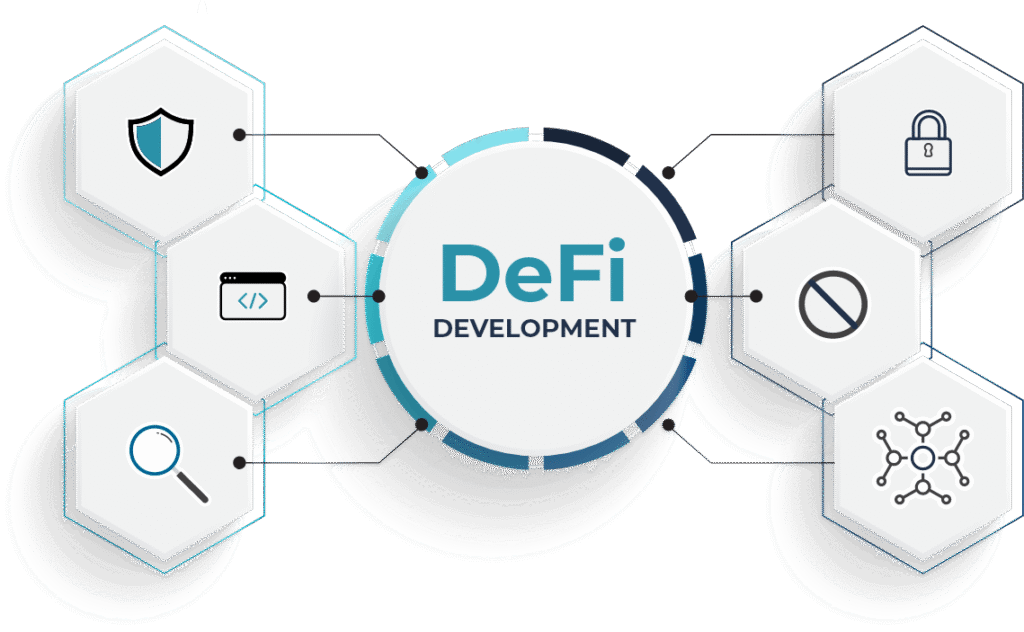
The rapid evolution of blockchain technology has brought with it a range of transformative financial services. Among these innovations, DeFi (Decentralized Finance) staking has emerged as one of the most accessible and rewarding activities for users and developers alike. Whether you’re a crypto enthusiast, blockchain developer, or business looking to enter the decentralized finance space, understanding DeFi staking development is crucial.
This guide aims to provide a comprehensive introduction to DeFi staking, covering how it works, why it matters, and how you can develop or launch your own staking platform.
What is DeFi Staking?
DeFi staking development is a process that allows cryptocurrency holders to lock their digital assets into smart contracts on a decentralized platform to earn rewards. Unlike traditional finance, DeFi staking operates without intermediaries, offering transparency, accessibility, and often higher returns.
It typically involves Proof-of-Stake (PoS) or Delegated Proof-of-Stake (DPoS) blockchain networks where users support the network’s security and operations in exchange for staking rewards.
Why Is DeFi Staking Important?
DeFi staking plays a vital role in the broader blockchain ecosystem. Here’s why it matters:
- Network Security: It enhances the security and stability of PoS-based blockchains.
- Passive Income: Users earn rewards without needing to trade or sell their assets.
- Decentralization: Removes the need for banks or intermediaries.
- Liquidity Incentives: Some platforms offer liquidity staking, combining staking with yield farming.
For businesses, offering DeFi staking services can open new revenue streams and user engagement models.
Key Components of DeFi Staking Development
Developing a DeFi staking platform involves a well-coordinated blend of blockchain technologies and financial logic. The key components include:
1. Smart Contracts
Smart contracts are self-executing codes that handle staking logic from locking tokens to distributing rewards. They form the core of any DeFi staking system.
2. Staking Pools
A staking pool combines multiple users’ tokens to increase the chances of validating blocks and earning rewards. Pools can be open or limited to certain users.
3. User Dashboard
An intuitive front-end interface is essential. Users should be able to:
- Stake and unstake tokens
- Track rewards
- View lock-in periods
- Monitor total value locked (TVL)
4. Wallet Integration
DeFi platforms must integrate seamlessly with popular crypto wallets like MetaMask, Trust Wallet, or WalletConnect.
5. Token Support
Staking platforms must support the tokens native to their ecosystem or allow multi-token staking via bridges or wrapped tokens.
6. Security Framework
Security is non-negotiable. Regular audits, bug bounties, and adherence to DeFi security best practices are mandatory.
How Does DeFi Staking Work?
Here’s a simplified breakdown of how DeFi staking typically works:
- User Connects Wallet: A user connects their crypto wallet to the staking platform.
- Token Deposit: The user selects the amount and type of token to stake.
- Smart Contract Activation: A smart contract locks the tokens for a specified period.
- Reward Distribution: Based on network rules or platform algorithms, rewards are distributed at regular intervals.
- Unstaking & Withdrawal: After the lock-in period, the user can unstake their tokens and withdraw earnings.
Types of DeFi Staking Models
There are several models developers can choose from when building a staking platform:
- Fixed Staking
Users lock their tokens for a predefined time and earn fixed rewards.
- Flexible Staking
Users can withdraw their tokens anytime, though rewards may vary or be lower.
- Liquidity Staking
Users stake LP tokens (received from providing liquidity on AMMs like Uniswap), earning rewards from both staking and liquidity pool fees.
- Delegated Staking
Users delegate their tokens to validators, who handle block validation in return for a share of the rewards.
Benefits of DeFi Staking Development
For developers and businesses, DeFi staking opens up several opportunities:
Recurring Revenue
Staking fees, performance fees, and transaction fees offer sustainable monetization.
User Engagement
Staking encourages users to remain active and engaged on the platform.
Platform Liquidity
Increased token lock-ins enhance the total value locked (TVL), boosting platform credibility.
Brand Positioning
Launching a DeFi staking platform positions your brand as a serious player in the blockchain ecosystem.
Step-by-Step Guide to DeFi Staking Platform Development
Here’s how a typical DeFi staking development process looks:
- Define the Staking Model
Choose between fixed, flexible, or delegated staking based on your target users and blockchain.
- Choose the Blockchain
Popular choices include:
- Ethereum (widely adopted, high gas fees)
- BNB Chain (low fees, fast transactions)
- Polygon (scalable, Ethereum-compatible)
- Solana or Avalanche (high throughput)
- Smart Contract Development
Write and deploy staking smart contracts using Solidity (for EVM chains), Rust (for Solana), or Vyper. Test thoroughly using frameworks like Truffle or Hardhat.
- Front-End Development
Create a responsive, user-friendly UI with frameworks like React or Vue.js. Ensure mobile compatibility.
- Wallet and Token Integration
Integrate wallet services and support the staking tokens and reward mechanisms.
- Security Audits
Work with third-party security audit firms to review your smart contracts and platform.
- Launch and Marketing
Deploy your platform on the mainnet, list tokens on decentralized exchanges, and promote your product through community engagement and influencer partnerships.
Challenges in DeFi Staking Development
While the benefits are attractive, developers must navigate several challenges:
Smart Contract Vulnerabilities
Flaws in code can lead to hacks or financial loss. Security audits and testing are essential.
Regulatory Uncertainty
Staking services may come under financial regulations in various countries.
User Trust
Building credibility takes time. Transparent reward structures and community engagement are vital.
Network Congestion & Gas Fees
High gas fees (especially on Ethereum) can deter users. Layer 2 solutions or alternative chains can help.
Future Trends in DeFi Staking
DeFi staking is evolving rapidly. Some notable trends shaping the future include:
Liquid Staking
This allows users to stake tokens while still having access to liquidity via derivative tokens (e.g., stETH).
Cross-Chain Staking
Multi-chain platforms will enable staking of assets across different blockchains.
AI-Powered Staking Optimization
AI could help automate strategies for higher staking yields with minimal risk.
Institutional Adoption
With increased clarity and security, institutions may enter the staking space for passive income.
Should You Build a DeFi Staking Platform?
If you’re a startup, crypto exchange, or DeFi project looking to scale, offering staking can significantly boost platform utility and user retention. It not only improves token circulation but also deepens user commitment.
However, consider the complexity, cost, and regulatory implications before diving in. Partnering with an experienced DeFi staking development company can help streamline the process and ensure a secure and scalable platform.
Conclusion
DeFi staking is not just a buzzword it’s a foundational pillar of the decentralized finance ecosystem. For beginners, it offers a powerful way to earn passive income. For developers and businesses, it’s a strategic opportunity to tap into the fast-growing DeFi market.
By understanding the mechanics, benefits, and challenges of DeFi staking development, you’re well on your way to building or using platforms that are transforming the future of finance.






